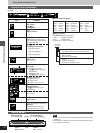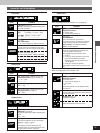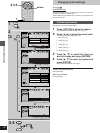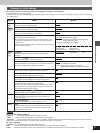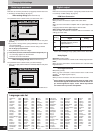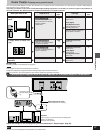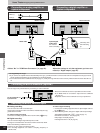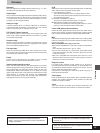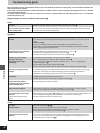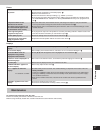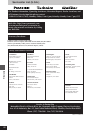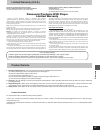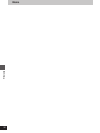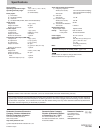
25
Reference
RQT6012
I/P/B
MPEG 2, the video compression standard adopted for use with DVD-
Video, codes frames using these 3 picture types.
I: Intra coded picture (I-picture)
This is the standard picture and is a complete picture in itself.
This means it has the best picture quality and is the best to use
when adjusting the picture.
P: Predictive coded picture (P-picture)
This picture is calculated based on past I or P-pictures.
B: Bidirectionally-predictive coded picture (B-picture)
This picture is calculated by comparing past and future I and P-
pictures so it has the lowest volume of information.
Linear PCM (pulse code modulation)
PCM is the usual digital method used for music CDs. DVDs have a
greater volume so they use linear PCM, which has a higher sampling
rate. Compressed PCM signals are called packed PCM (PPCM).
MP3
A method of compressing audio, MPEG Audio Layer 3 (MP3) allows
audio to be reduced to up to one tenth its original size without overtly
hurting audio quality.
When creating MP3 files to play on this unit
³Disc formats: ISO9660 level 1 and level 2 (except for extended for-
mats)
Files: MP3 files with the suffix “.mp3” or “.MP3”
³To have this unit play files in a certain order, prefix folder and file
names with numbers in the order you want to play them. This may
not work in all cases.
³This unit is compatible with multi-session but if there are a lot of
sessions it takes more time for play to start. Keep the number of
sessions to a minimum to avoid this.
Playback control
If a Video CD has “playback control” written on it or its jacket, it
means that particular scenes or information can be selected for view-
ing interactively with the television using the menu screen. This unit
can play Video CDs with playback control.
Using menus to control play of a Video CD is called “menu play” in
these operating instructions.
Title/Chapter
DVDs are divided up into large sections, titles, and smaller sections,
chapters. The numbers allocated to these sections are called title
numbers and chapter numbers.
Track
Video CDs and CDs are divided up into sections called tracks, and
the numbers allocated to these sections are called track numbers.
Bitstream
This is the digital form of multiple channel audio data (e.g., 5.1 chan-
nel) before it is decoded into its various channels.
Dolby Digital
This is a method of coding digital signals developed by Dolby Labora-
tories. Apart from stereo (2-channel) audio, these signals can also be
5.1-channel audio. A large amount of audio information can be re-
corded on one disc using this method.
Dolby Pro Logic
A surround system where a 4-channel audio track is recorded as
2 channels and then is restored to 4 channels for play. The surround
channel is monaural and can reproduce up to 7 kHz.
DTS (Digital Theater Systems)
This surround system is used in many movie theaters around the
world. There is good separation between the channels, so realistic
sound effects are possible.
Dynamic range
Dynamic range is the difference between the lowest level of sound
that can be heard above the noise of the equipment and the highest
level of sound before distortion occurs.
Film and video
DVDs are recorded using either film or video. Usually, film is record-
ed at 24 frames per second, the rate movies are filmed at, while video
is recorded at 30 frames per second.
Frame
Frames are the still pictures that go together to make a moving
picture. There are about 30 frames shown each second.
Interlace and progressive output
NTSC, the video signal standard, has 480 interlaced (i) scan lines,
whereas progressive scanning uses twice the number of scan lines.
This is called 480p. The 480i video signals output from this unit’s
COMPONENT VIDEO OUT terminals (Y, P
B, PR) allow you to enjoy
higher quality pictures than if the signals were output from the video
output terminal or S VIDEO OUT terminal. The COMPONENT
VIDEO OUT terminals are also able to handle 480p (progressive)
video signals which are of even greater resolution.
Glossary
“DTS” and “DTS Digital Out” are trademarks of Digital Theater
Systems, Inc.
“DTS” and “DTS Digital Surround” are registered trademarks
of Digital Theater Systems, Inc.
Manufactured under license from Dolby Laboratories.
“Dolby”, “Pro Logic” and the double-D symbol are trademarks
of Dolby Laboratories.




